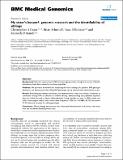| dc.contributor.author | Cassa, Christopher A. | en_US |
| dc.contributor.author | Schmidt, Brian | en_US |
| dc.contributor.author | Kohane, Isaac | en_US |
| dc.contributor.author | Mandl, Kenneth D. | en_US |
| dc.date.accessioned | 2009-10-19T13:35:32Z | |
| dc.date.available | 2009-10-19T13:35:32Z | |
| dc.date.issued | 2008-07 | en_US |
| dc.date.submitted | 2007-11 | en_US |
| dc.identifier.issn | 1755-8794 | en_US |
| dc.identifier.uri | http://hdl.handle.net/1721.1/49471 | |
| dc.description.abstract | Background: Genomic sequencing of SNPs is increasingly prevalent, though the amount of familial
information these data contain has not been quantified.
Methods: We provide a framework for measuring the risk to siblings of a patient's SNP genotype
disclosure, and demonstrate that sibling SNP genotypes can be inferred with substantial accuracy.
Results: Extending this inference technique, we determine that a very low number of matches at
commonly varying SNPs is sufficient to confirm sib-ship, demonstrating that published sequence
data can reliably be used to derive sibling identities. Using HapMap trio data, at SNPs where one
child is homozygotic major, with a minor allele frequency ≤ 0.20, (N = 452684, 65.1%) we achieve
91.9% inference accuracy for sibling genotypes.
Conclusion: These findings demonstrate that substantial discrimination and privacy risks arise
from use of inferred familial genomic data. | en_US |
| dc.language.iso | en_US | en_US |
| dc.publisher | BioMed Central Ltd. | en_US |
| dc.relation.isversionof | http://dx.doi.org/10.1186/1755-8794-1-32 | en_US |
| dc.rights | Creative Commons Attribution | en_US |
| dc.rights.uri | http://creativecommons.org/licenses/by/2.0 | en_US |
| dc.source | Publisher | en_US |
| dc.title | My sister's keeper?: genomic research and the identifiability of siblings | en_US |
| dc.type | Article | en_US |
| dc.identifier.citation | Cassa, Christopher, Brian Schmidt, Isaac Kohane, and Kenneth Mandl. 2008. My sister's keeper?: genomic research and the identifiability of siblings. BMC Medical Genomics 1, no. 1: 32. | en_US |
| dc.contributor.department | Harvard University--MIT Division of Health Sciences and Technology | en_US |
| dc.contributor.department | Massachusetts Institute of Technology. Computer Science and Artificial Intelligence Laboratory | en_US |
| dc.contributor.department | Massachusetts Institute of Technology. Department of Civil and Environmental Engineering | en_US |
| dc.contributor.approver | Cassa, Christopher A. | en_US |
| dc.contributor.mitauthor | Cassa, Christopher A. | en_US |
| dc.contributor.mitauthor | Schmidt, Brian | en_US |
| dc.contributor.mitauthor | Kohane, Isaac | en_US |
| dc.contributor.mitauthor | Mandl, Kenneth D. | en_US |
| dc.relation.journal | BMC Medical Genomics | en_US |
| dc.eprint.version | Final published version | en_US |
| dc.identifier.pmid | 18655711 | en_US |
| dc.type.uri | http://purl.org/eprint/type/JournalArticle | en_US |
| eprint.status | http://purl.org/eprint/status/PeerReviewed | en_US |
| dspace.orderedauthors | Cassa, Christopher A; Schmidt, Brian; Kohane, Isaac S; Mandl, Kenneth D | en |
| mit.license | PUBLISHER_CC | en_US |
| mit.metadata.status | Complete | |
